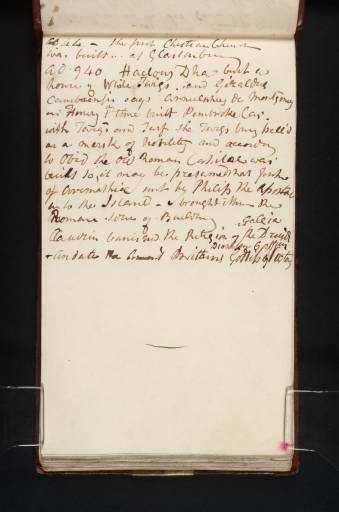Joseph Mallord William Turner Historical Notes (Inscriptions by Turner) c.1808-10
Image 1 of 2
Joseph Mallord William Turner,
Historical Notes (Inscriptions by Turner)
c.1808-10
Joseph Mallord William Turner 1775–1851
Folio 90 Verso:
Historical Notes (Inscriptions by Turner) circa 1808–10
D07110
Turner Bequest CV 80a
Turner Bequest CV 80a
Inscribed by Turner in ink (see main catalogue entry) on white wove paper, 185 x 108 mm
Accepted by the nation as part of the Turner Bequest 1856
References
1897
Walter Thornbury, The Life of J.M.W. Turner, R.A. Founded on Letters and Papers Furnished by his Friends and Fellow-Academicians: A New Edition, Revised with 8 Coloured Illustrations after Turner’s Originals and 2 Woodcuts, London 1897, p.486.
1909
A.J. Finberg, A Complete Inventory of the Drawings of the Turner Bequest, London 1909, vol.I, p.279, CV 80a.
1990
Andrew Wilton and Rosalind Mallord Turner, Painting and Poetry: Turner’s ‘Verse Book’ and his Work of 1804–1812, exhibition catalogue, Tate Gallery, London 1990, p.131.
1997
Anthony Bailey, Standing in the Sun: A Life of J.M.W. Turner, London 1997, p.161.
Turner’s inscription reads:
A.D 44, the first Christian Church | was built at Glastonbury | A.D. 940 Haelou Dha built a | house of White Twigs, and Giraldus | Cambrensis says Arnulphus de Montgomery | in Henry I time built Pembroke Cas. | with Twigs and Turf the Twigs being peel’d | as a mark of nobility and according | to Ovid the Old Roman Capital was | built so, it may be presumed that Joseph | of Arimathea sent by Philip the Apostle | into the Island, brought [h]ither the | Roman love of Building | Claudius banished the Religion of [Gallia inserted] the Druids [Dio... Cassius inserted] Andate the Ancient Britains Goddess of Victory
Thornbury described these notes as ‘Incoherences still more puzzling [than others in the sketchbook]’ but some of Turner’s meanings and sources can be explained. He cites the tradition that Joseph of Arimathea brought Christianity to England and built a cathedral at Glastonbury within decades of the death of Christ, thus being an apostle of architecture as well as religion. The same legend inspired William Blake to engrave his print Joseph of Arimathea among the Rocks of Albion with its descriptive underline ‘This is One of the Gothic Artists who built the Cathedrals in what we call the Dark Ages’. There are further notes on the Emperor Claudius, based on the Lives of the Caesars by Gaius Suetonius Tranquillus (circa 70–circa 140 AD) on folio 91 verso of the sketchbook (D07112; Turner Bequest CV 81a). Here, Turner names the Greek-born historian of Rome, Cassius Dio (164–circa 235 AD) who told of Queen Boadicca invoking Andraste, the Icenic goddess of Victory, against the Roman occupation in 61 AD.
Giraldus Cambrensis (Gerald of Wales ?1146–?1220), cleric and historian, was the author of a famous Itinerarium or Journey through Wales, discussing topography, architecture and history. Turner may have researched it in connection with his visit to North Wales in 1808 (see Introduction to the sketchbook). His interest in Welsh and druidical history could have been prompted by Richard Colt Hoare if he visited him at his holiday villa at Bala or travelled with him during his tour that summer. Hoare had published an edition of Giraldus in 1806 and was currently researching an Ancient History of Wiltshire. The construction of a ‘White House’ by
Hoel Dha (Hoel the Good) in 914 is described by various historians including William Camden and Thomas Fuller whose The Church-History of Britain (1655, book I, p.7) is mentioned, together with Giraldus’s account of the preference of the Welsh gentry for ‘houses constructed of wattles’ in Frank Sayers, Disquisitions, 2nd ed., Norwich 1808, p.220. Sayers also comments on the ‘great architectural skill’ acquired by the British in Roman times.1
Hoel Dha (Hoel the Good) in 914 is described by various historians including William Camden and Thomas Fuller whose The Church-History of Britain (1655, book I, p.7) is mentioned, together with Giraldus’s account of the preference of the Welsh gentry for ‘houses constructed of wattles’ in Frank Sayers, Disquisitions, 2nd ed., Norwich 1808, p.220. Sayers also comments on the ‘great architectural skill’ acquired by the British in Roman times.1
David Blayney Brown
June 2010
How to cite
David Blayney Brown, ‘Historical Notes (Inscriptions by Turner) c.1808–10 by Joseph Mallord William Turner’, catalogue entry, June 2010, in David Blayney Brown (ed.), J.M.W. Turner: Sketchbooks, Drawings and Watercolours, Tate Research Publication, December 2012, https://www


